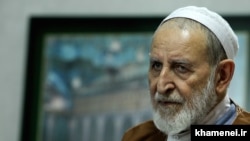The chairman of the influential Qom’s Society of Seminary Teachers, Ayatollah Mohammad Yazdi, has officially petitioned the Guardian Council (GC) to define the constitutionally sensitive term “political religious personality” that denotes who is allowed to run for president in Iran.
In an interview with Mehr News Agency (MNA), GC spokesman Abbas Ali Kadkhodaei confirmed that Yazdi has officially tabled the request but the date for addressing the controversial term was yet to be decided.
Yazdi himself is a member of the GC, which is the electoral supervisory body in Iran.
The archaic and ambiguous Arabic term mentioned in Article 115 of the Iranian Constitution (rajal-i siasi maz-habi) has been the main obstacle against Iranian women running for president. The term could either be interpreted exclusively as referring to “men” or “personalities,” which would include women, as well.
Women’s rights activists in Iran have fought for almost four decades in favor of the latter interpretation. In the last presidential election in May, nearly 140 women came forward and nominated themselves for the highest executive job in Iran.
Azam Taleghani, a former MP and daughter of one of the founders of Iran’s Islamic Republic, Ayatollah Mahmoud Taleghani, was once again among the female nominees. Nevertheless, she was disqualified by the GC along with all other female presidential hopefuls.
Earlier, on August 10, the GC’s spokesman had announced that the term “political religious personality” would to be interpreted and defined.
However, this is the first time that a member of the all-male GC has reportedly officially demanded a definition for the controversial term.
Many women’s rights activists believe the Arabic term “rajol” and its plural form “rajal” do not exclusively mean “man” or “men” and that it refers to women, as well. Therefore, women are also eligible for the presidency. Despite the fact that women comprise almost half of the electorate in Iran, the GC has always disqualified female candidates.
Quoting the GC’s spokesman, MNA reported that the term, as well as its related words, has been discussed at several sessions of the GC and by its Research Center.
“Since the case has many dimensions, it is not yet clear when the final decision on defining the term will be announced,” Kadkhodaei told MNA.
Political activists say the GC must define the ambiguous term on its “conventional or legal aspect,” while there are others who favor “a jurisprudence definition” for it.
Meanwhile, some say it should be up to the Expediency Council to resolve the problem.
The debate on the definition of the ambiguous and archaic term has become topical again at a time when Iranian women’s aspirations to have a representative in President Hassan Rouhani’s new cabinet proved unattainable.
The only woman to hold a cabinet position in Iran since 1979 is Marzieh Dastjerdi, who served as health minister from 2009 to 2013 under Mahmud Ahmadinejad.
Iran is one of the first countries in the region to have appointed women as cabinet minister. Farrokhroo Parsa was an Iranian physician, educator, and parliamentarian as well as the first female cabinet minister under the Shah, from 1968 to 1971.
After the 1979 revolution, she was accused of ambiguous charges by an Islamic revolutionary court and later executed by a firing squad.



